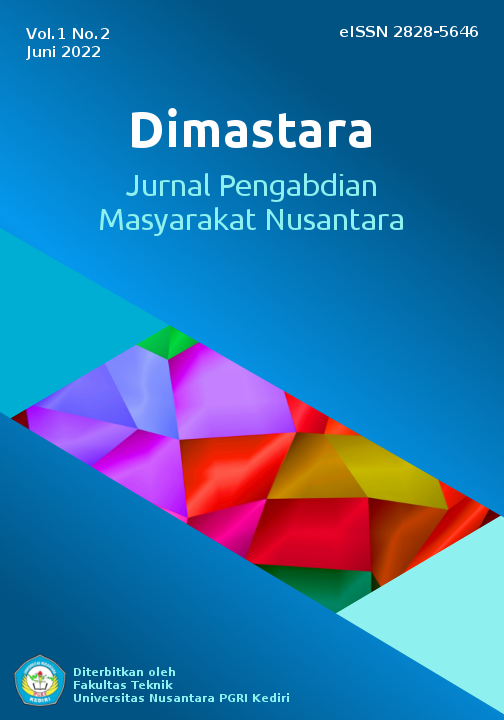PkM Penerapan Teknologi Tepat Guna Berbasis Teknologi Terbarukan di Dusun Kweden Desa Karangrejo Kec. Ngasem
DOI:
https://doi.org/10.29407/dimastara.v1i2.17957Keywords:
electrical energy, renewable energy, solar panelsAbstract
Electricity is one of the most important human needs today, as over time almost all inhabitants will need electricity in every aspect of their lives, from urban to rural areas. In Indonesia, people generally get power from PLN (State Electricity Company). The demand for electrical energy increasingly exceeds the availability of the electrical energy of PLN, so alternative energy is needed to make up for the shortage of electrical energy. As a tropical country, Indonesia has significant potential to use solar energy as electrical energy, because solar energy is a renewable energy that is cheap, simple and above all environmentally friendly and always available.
In Kweden Hamlet, Karangrejo village, Ngasem district, Kediri Regency, there are 2 graves used by all residents of Kweden Hamlet. A special grave for certain families and a general grave generally used by the entire population of the hamlet of Kweden. In the hamlet of Kweden, it is customary for anyone who dies at any time of the day, noon, or even midnight to be buried immediately. Sufficient lighting is therefore needed in the grave area so that the burial process from grave digging to burial can be carried out as well as possible.
Due to the limited number of light points, poor installation and sometimes delayed payment of electricity bills, the lighting in the burial space is not optimal. The lack of information about alternative electrical energy still makes the population of the hamlet of Kweden dependent on the electrical energy supplied by PLN. The solution offered to solve the problems in the hamlet of Kweden is to illuminate the tomb with solar panel lighting so that there is no monthly fee, and to educate the public that there is alternative electrical energy that uses renewable energy which is easy and cheap. Based on the area of the grave, the number of required solar panel lamps is determined to be 24 lamps. Meanwhile, education in alternative electrical energy managed to change people's perception of it and saw a significant increase from where 82.61% of respondents previously said solar panels were expensive. Training showed that only 26.09% of respondents said solar panels are expensive.
Downloads
References
[1] Humas EBTKE, “Direktorat Jenderal EBTKE - Kementerian ESDM,” 2020. https://ebtke.esdm.go.id/post/2020/10/22/2667/menteri.arifin.transisi.energi.mutlak.diperlukan?lang=en (accessed Nov. 25, 2020).
N. M. Said, M. Y. Jinca, and Y. K. Dewi, “Analisis Energi Terbarukan Tenaga Surya Sebagai Pengganti Energi Konvensional Untuk Traffic Light di Kota Makassar,” JURNAL INFRASTRUKTUR, vol. 05, no. 01, pp. 37–44, Jun. 2019.
L. Magalhaes, “Model Pemberdayaan Berbasis Pemanfaatan Sumberdaya Alam yang Berkelanjutan: Studi pada Program Energi Terbarukan di Kabupaten Jombang,” Journal of Economics Developments Issues (JEDI), vol. 01, no. 01, pp. 12–25, Jun. 2018.
I. B. K. Sugirianta, A. Keekonomian, T. Listrik, I. A. D. Giriantari, and I. N. S. Kumara, “ANALISA KEEKONOMIAN TARIF LISTRIK PEMBANGKIT LISTRIK TENAGA SURYA 1 MWP BANGLI DENGAN METODE LIFE CYCLE COST,” Teknologi Elektro, vol. 15, no. 2, 2016.
M. A. A. Nugroho, Kecamatan Ngasem Dalam Angka 2021. Badan Pusat Statistik Kabupaten Kediri, 2021.
Downloads
Published
Issue
Section
License
Penulis yang menerbitkan jurnal ini menyetujui persyaratan berikut:
- Hak cipta atas artikel apa pun dipegang oleh penulisnya.
- Penulis memberikan jurnal, hak publikasi pertama dengan karya yang dilisensikan secara bersamaan di bawah Lisensi Atribusi Creative Commons yang memungkinkan orang lain untuk membagikan karya dengan pengakuan atas kepenulisan dan publikasi awal karya tersebut dalam jurnal ini.
- Penulis dapat membuat pengaturan kontrak tambahan yang terpisah untuk distribusi non-eksklusif dari versi jurnal yang diterbitkan dari karya tersebut (misalnya, mempostingnya ke repositori institusional atau menerbitkannya dalam sebuah buku), dengan pengakuan dari publikasi awalnya di jurnal ini.
- Penulis diizinkan dan didorong untuk memposting karya mereka secara online (misalnya, di repositori institusional atau di situs web mereka) sebelum dan selama proses pengiriman, karena hal itu dapat mengarah pada pertukaran yang produktif, serta kutipan yang lebih awal dan lebih besar dari karya yang diterbitkan.
- Artikel dan materi terkait yang diterbitkan didistribusikan di bawah Lisensi Internasional Creative Commons Attribution-ShareAlike 4.0













